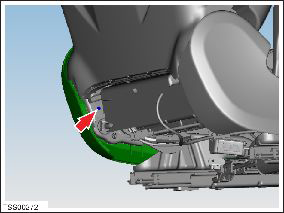Tesla Model S: Assembly - Back Rest - Driver's Seat (Remove and Replace)
Tesla Model S (2012-2025) Service Manual / Seats / Assembly - Back Rest - Driver's Seat (Remove and Replace)
Removal
- Remove driver's seat assembly (refer to procedure)
- Place seat on clean work surface.
- Remove screw securing outer side cover to seat (torque 1 Nm).

- Carefully release outer side cover from retaining bracket and lay it aside with harnesses still connected.
- Remove outer side cover assembly.
- Remove screw securing inner side cover to seat (torque 1 Nm).

- Carefully release inner side cover from retaining bracket.
- Release clip securing seat harness to cover.
- Remove inner side cover.
- Reposition seat.
- Disconnect seat back rest heater element connector and harness.
- Disconnect seat back lumbar support connector and harness.
- Disconnect side airbag connector and harness.
- With assistance, remove bolts (x4) securing seat back rest to
seat base and remove seat back rest assembly and place aside (torque
32 Nm). NOTE: LH bolts shown.

READ NEXT:
 Frame - Seat Base - 2nd Row Cushion (Remove and Replace)
Frame - Seat Base - 2nd Row Cushion (Remove and Replace)
Removal
Remove the seat cushion (refer to procedure).
Remove the LH rear seat back rest assembly (refer to procedure).
Remove the RH rear seat back rest assembly (refer to procedu
 Frame - Seat Base - 2nd Row - Executive (Remove and Replace)
Frame - Seat Base - 2nd Row - Executive (Remove and Replace)
Removal
Remove the 2nd row back rest assembly (refer to procedure).
Dual Motor vehicles only: Release the fasteners
(x4) that secure the inline fuse bracket to the seat frame (torque
 Frame - Seat Back - 2nd Row Seat - LH (Remove and Replace)
Frame - Seat Back - 2nd Row Seat - LH (Remove and Replace)
Removal
Remove Rear LH seat back rest assembly and remove Pivot lock
from outboard side of assembly (refer to procedure)
Release and remove latch cover from seat back.
SEE MORE:
 Cabin Camera
Cabin Camera
Your Model S may be equipped with a cabin camera
located above the rear view mirror.
The cabin camera can determine driver inattentiveness
and provide you with audible alerts, to remind you to
keep your eyes on the road when Autopilot is engaged.
By default, images and video from the camera do
 SIM Card - With SIM Extender (Remove and Replace)
SIM Card - With SIM Extender (Remove and Replace)
Note: Vehicles in North America are not equipped with
a SIM extender; this procedure only applies to vehicles outside
of North America.
Removal
Remove the center underhood apron (refer to procedure).
Remove the cover from fuse box 2.
© 2019-2025 Copyright www.tesms.org

